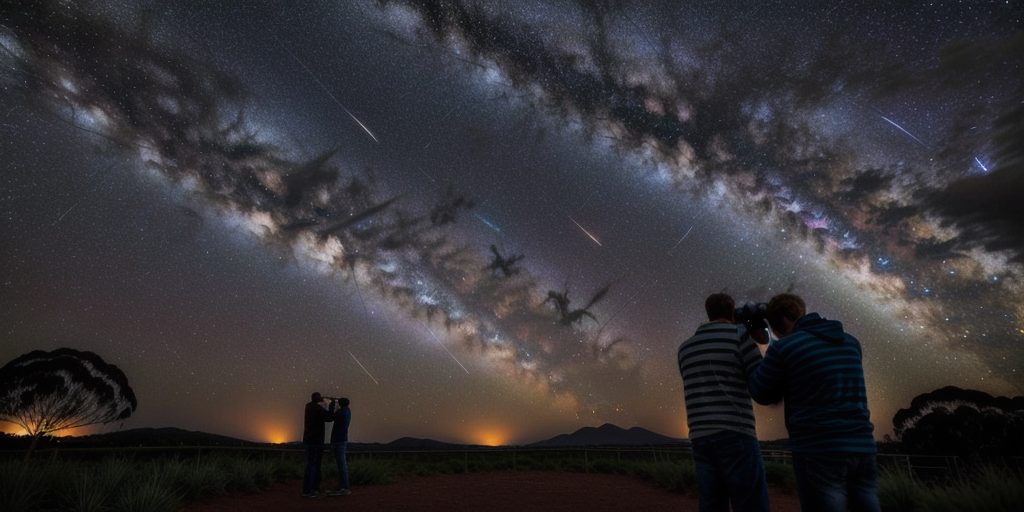
Australian stargazers to enjoy two meteor showers this week – and you can leave the binoculars at home
How did your country report this? Share your view in the comments.
Diverging Reports Breakdown
Australian stargazers to enjoy two meteor showers this week – and you can leave the binoculars at home
Stargazers and night owls in Australia will be in prime position to catch a glimpse of two spectacular meteor showers this week. The Southern Delta Aquariids and the Alpha Capricornids showers will be visible between 11pm and dawn on Tuesday and Wednesday. But meteor showers are best seen away from the city lights, according to Jonti Horner, professor of astrophysics at the University of Southern Queensland. The Delta Aquaridds are coming in at about 40kms a second, while theAlpha CapricORNids are travelling at about 22kms. The radiant is the apparent origin of a meteor shower in the sky, from the point of view of an observer on the ground. Horner said that you can visualise a meteor showers as being a stream of debris crossing the earth’s orbit where all of the debris particles are travelling in the same direction.
The good news is that you won’t need a telescope or a pair of binoculars to see the Southern Delta Aquariids and the Alpha Capricornids showers – just your own eyes.
Here’s what you need to know about the meteor showers and where you can see them.
Where can I watch the meteor showers? The southern hemisphere is likely to have a great view of both the meteor showers, with Australia in prime position to enjoy them. But meteor showers are best seen away from the city lights, according to Jonti Horner, professor of astrophysics at the University of Southern Queensland. Starwatch: Summer is the time to look for the constellation Sagittarius Read more He recommends stargazers scope out a potential viewing spot during the day – ideally somewhere away from buildings, street lamps and car headlights – to return to at night. Stargazers should also check the weather each evening to decide which night to venture out into, with rain forecast in Sydney for Wednesday and some cloud cover predicted in Melbourne and Brisbane this week.
When can I see the meteor showers? The best time to view the showers will be between 11pm and dawn on Tuesday and Wednesday. The showers were also visible on Monday. “When the radiant rises you will start to see them but the higher the radiants get in the sky the better the view will be,” Horner said. The radiant is the apparent origin of a meteor shower in the sky, from the point of view of an observer on the ground. “So the radiant of the Southern Delta Aquariids, which is the stronger of the two showers, is highest at around 2.00am local time, which means any time between 11pm and dawn would be the prime time.” He said that the radiant for the Alpha Capricornids is highest a couple of hours earlier just before midnight, but warned it may put on a less luminous show. The Delta Aquaridds are coming in at about 40kms a second, while the Alpha Capricornids are travelling at about 22kms a second.
What are the best stargazing tips for how to watch? Although some might be tempted to break out the binoculars or even the telescope to enjoy the meteor showers, Horner believes it’s best just to use your own eyes. “The reason for that is you’ll want to have the widest possible field of view to be able to see the biggest amount of sky that you can, because the meteors that you see are bit of dust and debris hitting our atmosphere,” Horner said. “If you’re looking through binoculars or a telescope you’ve just got such small field of view that you won’t see them.” He also recommended not spending too much time looking at your phone screen beforehand so your eyes can adjust to the darkness faster – which allows you to spot the lights better. “It takes about 45 minutes for your eyes to fully adapt to the darkness but you get most of your adaptation in the first 5 minutes,” Horner said. Horner also suggested taking a chair or blanket with some pillows to lie down on to avoid a sore neck, while downloading an app that maps the night sky is a helpful way to know which way to look.
Why does a meteor shower happen? Horner said that you can visualise a meteor shower as being a stream of debris crossing the earth’s orbit where all of the debris particles are travelling in the same direction. “So that debris when it’s coming towards the earth it will hit the earth from a specific direction” Horner said. “The result that we observe is that the meteors can appear in any part of the night sky but they will always trace back to that point in the sky that is the direction the meteors are coming from.” He said that the point where meteors are coming from is called the radiant of the meteor shower and so each shower’s name derives from the constellation that their radiant is in.
